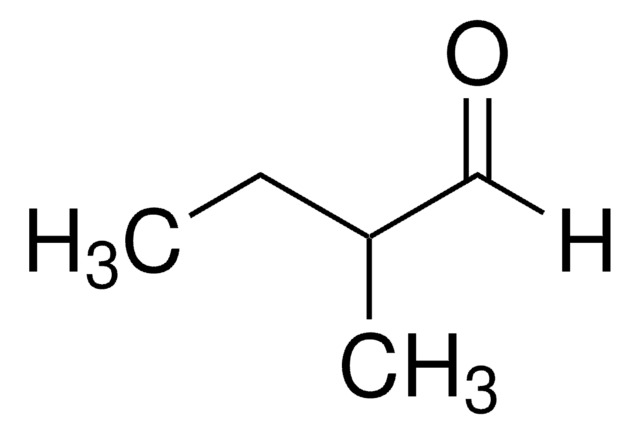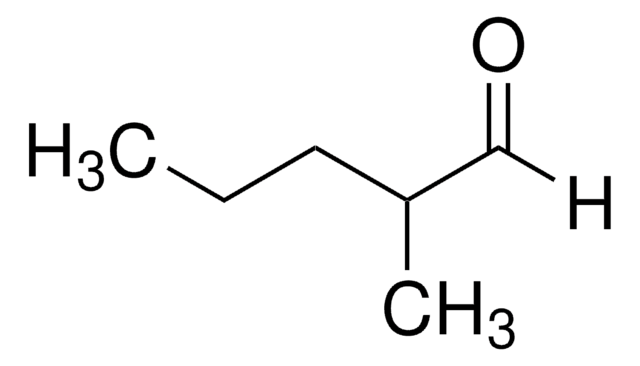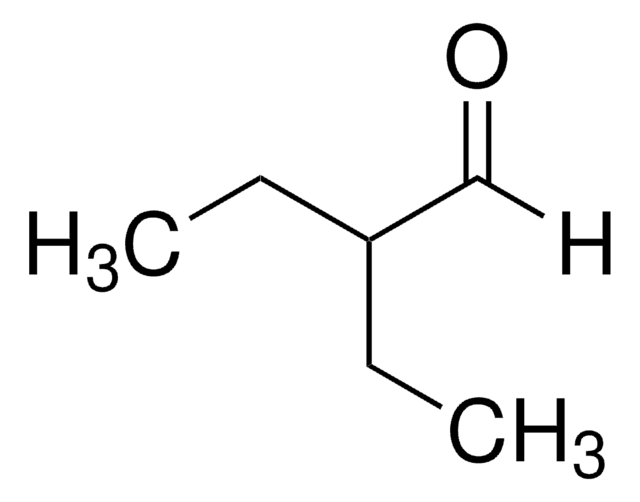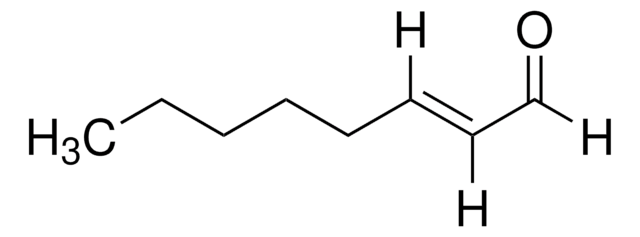W269107
2-Methylbutyraldehyde
≥95%, FG
Sinónimos:
2-Methylbutanal
About This Item
Productos recomendados
origen biológico
synthetic
Nivel de calidad
grado
FG
Fragrance grade
Halal
Kosher
Agency
(EU Regulation 1223/2009)
(follows IFRA guidelines)
cumplimiento norm.
EU Regulation 1334/2008 & 178/2002
FDA 21 CFR 117
FDA 21 CFR 172.515
Ensayo
≥95%
impurezas
<5% isopentanal
índice de refracción
n20/D 1.3919 (lit.)
bp
90-92 °C (lit.)
densidad
0.806 g/mL at 20 °C
0.804 g/mL at 25 °C (lit.)
aplicaciones
flavors and fragrances
Documentación
see Safety & Documentation for available documents
alérgeno alimentario
no known allergens
alérgeno de la fragancia
no known allergens
Organoléptico
chocolate; coffee
cadena SMILES
[H]C(=O)C(C)CC
InChI
1S/C5H10O/c1-3-5(2)4-6/h4-5H,3H2,1-2H3
Clave InChI
BYGQBDHUGHBGMD-UHFFFAOYSA-N
¿Está buscando productos similares? Visita Guía de comparación de productos
Categorías relacionadas
Descripción general
Aplicación
- In Staphylococcus aureus, the acyl-CoA synthetase MbcS supports branched-chain fatty acid synthesis from carboxylic acid and aldehyde precursors.: This study explores the role of the enzyme MbcS in Staphylococcus aureus, demonstrating how it utilizes 2-Methylbutyraldehyde as a precursor in the synthesis of branched-chain fatty acids, which are essential for bacterial growth and virulence (Dos Santos Ferreira et al., 2024).
- Volatile Short-Chain Aliphatic Aldehydes Act as Taste Modulators through the Orally Expressed Calcium-Sensing Receptor CaSR.: This study investigates how volatile short-chain aldehydes, including 2-Methylbutyraldehyde, modulate taste perception through the calcium-sensing receptor CaSR, providing insights into their potential applications in food and flavor industries (Kitajima et al., 2023).
Palabra de señalización
Danger
Frases de peligro
Consejos de prudencia
Clasificaciones de peligro
Aquatic Chronic 2 - Eye Irrit. 2 - Flam. Liq. 2 - Skin Sens. 1 - STOT SE 3
Órganos de actuación
Respiratory system
Código de clase de almacenamiento
3 - Flammable liquids
Clase de riesgo para el agua (WGK)
WGK 2
Punto de inflamabilidad (°F)
23.0 °F
Punto de inflamabilidad (°C)
-5 °C
Equipo de protección personal
Eyeshields, Faceshields, Gloves, type ABEK (EN14387) respirator filter
Elija entre una de las versiones más recientes:
¿Ya tiene este producto?
Encuentre la documentación para los productos que ha comprado recientemente en la Biblioteca de documentos.
Los clientes también vieron
Global Trade Item Number
| Número de referencia del producto (SKU) | GTIN |
|---|---|
| W269107-1KG | |
| W269107-200G | |
| W269107-4KG | |
| W269107-4KG-K | |
| W269107-1KG-K | 4061837515996 |
| W269107-SAMPLE | |
| W269107-100G | |
| W269107-100G-K | 4061837835070 |
| W269107-1G | |
| W269107-800G | |
| W269107-8KG | |
| W269107-8KG-K | 4061837835087 |
| W269107-SAMPLE-K | 4061837516009 |
Nuestro equipo de científicos tiene experiencia en todas las áreas de investigación: Ciencias de la vida, Ciencia de los materiales, Síntesis química, Cromatografía, Analítica y muchas otras.
Póngase en contacto con el Servicio técnico













